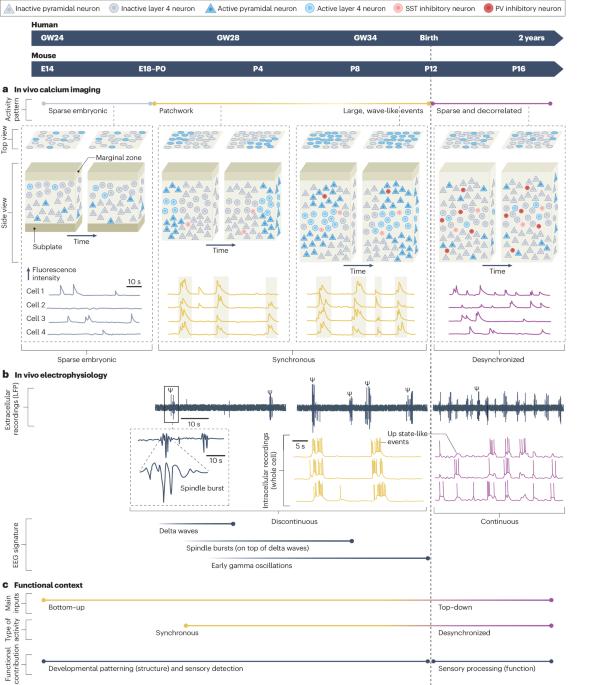大脑皮层发育过程中的网络状态转换
IF 28.7
1区 医学
Q1 NEUROSCIENCES
引用次数: 0
摘要
哺乳动物的皮层网络在突触发生真正开始之前、神经元迁移完成之前,以及动物睁开眼睛开始主动探索周围环境之前就已经活跃起来。这种早期活动在发育过程中经历了多次转变。其中最重要的转变是从偶发的同步网络事件向非同步活动的过渡,前者是将新皮层模式化为功能相关模块的必要条件,后者在计算上更强大、更高效。在大脑缓慢而渐进的成熟过程中,网络非同步化也许是最戏剧性和最突然的发展事件。在这篇综述中,我们总结了目前已知的啮齿动物新皮层发育同步活动的现象,并推测了驱动其最终去同步化的机制。我们认为,网络活动的非同步化是大脑皮层从被动的、自下而上的感官刺激检测过渡到主动的、自上而下的感官处理的一个基本步骤。本文章由计算机程序翻译,如有差异,请以英文原文为准。


Network state transitions during cortical development
Mammalian cortical networks are active before synaptogenesis begins in earnest, before neuronal migration is complete, and well before an animal opens its eyes and begins to actively explore its surroundings. This early activity undergoes several transformations during development. The most important of these is a transition from episodic synchronous network events, which are necessary for patterning the neocortex into functionally related modules, to desynchronized activity that is computationally more powerful and efficient. Network desynchronization is perhaps the most dramatic and abrupt developmental event in an otherwise slow and gradual process of brain maturation. In this Review, we summarize what is known about the phenomenology of developmental synchronous activity in the rodent neocortex and speculate on the mechanisms that drive its eventual desynchronization. We argue that desynchronization of network activity is a fundamental step through which the cortex transitions from passive, bottom–up detection of sensory stimuli to active sensory processing with top–down modulation. At early developmental stages, spontaneous activity in the mammalian cortex is characterized by the occurrence of highly synchronous network events. Portera-Cailliau and colleagues describe these activity patterns, their underlying mechanisms and function, and their transition to the desynchronized activity observed in adult individuals.
求助全文
通过发布文献求助,成功后即可免费获取论文全文。
去求助
来源期刊

Nature Reviews Neuroscience
NEUROSCIENCES-
自引率
0.60%
发文量
104
期刊介绍:
Nature Reviews Neuroscience is a multidisciplinary journal that covers various fields within neuroscience, aiming to offer a comprehensive understanding of the structure and function of the central nervous system. Advances in molecular, developmental, and cognitive neuroscience, facilitated by powerful experimental techniques and theoretical approaches, have made enduring neurobiological questions more accessible. Nature Reviews Neuroscience serves as a reliable and accessible resource, addressing the breadth and depth of modern neuroscience. It acts as an authoritative and engaging reference for scientists interested in all aspects of neuroscience.
 求助内容:
求助内容: 应助结果提醒方式:
应助结果提醒方式:


